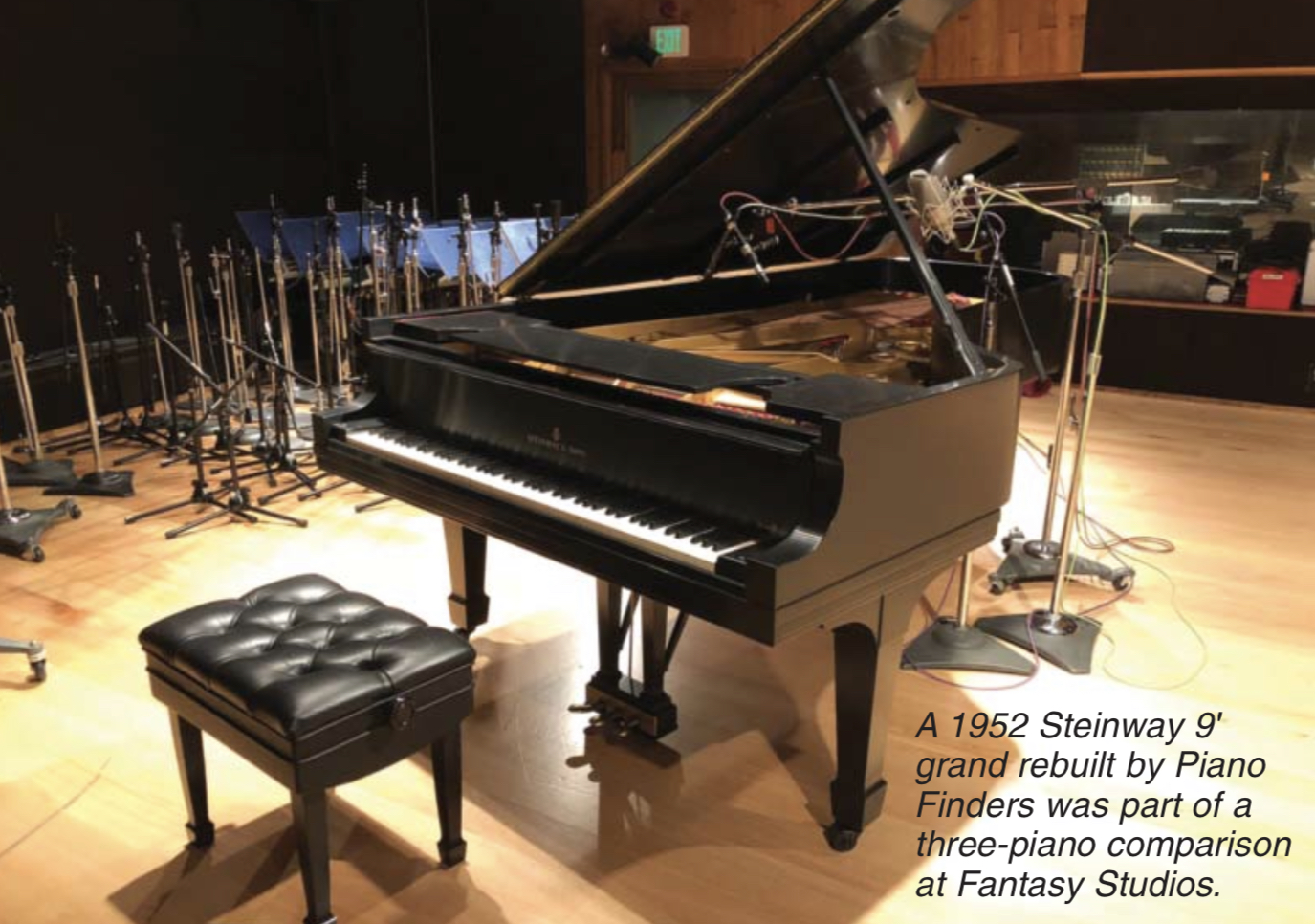Karen Lile, an independent executive producer and co-owner of Piano Finders, brings together Grammy winners and top producers for one special benefit album. Article Courtesy of Music Trades Magazine (The Global Issue): 40–42. December 2018.
A 1952 Steinway 9′ grand rebuilt by Piano Finders was part of a three-piano comparison at Fantasy Studios.
SEVENTY HOURS in a recording studio is enough time to lay down quite a lot of tracks. It was up to Karen Lile to decide how to use them. An independent executive producer and co-owner of the San Francisco-based Piano Finders firm, Lile had a long history with Fantasy Studios in nearby Berkeley. As an inde- pendent executive producer, she’d pro- duced recording sessions there since 1987. At Piano Finders, a rebuilding, appraisal, and brokerage service, her part- ner Kendall Ross Bean had rebuilt four prized pianos in use there. Then, in September 2018, Fantasy Studios announced it would be closing. At the time, Piano Finders still had a 70-hour credit with the studios, the result of busi- ness previously transacted between the two companies: a rebuilding project Piano Finders had carried out on jazz great Bill Evan’s 7’4″ Yamaha grand (later acquired by Fantasy Studios), and a separate arrangement by Bean, a concert pianist, to lay down some classical and jazz recordings in 2019. With the studios closing in a matter of weeks, though, 2019 would be too late to use those 70 hours. Lile’s two careers converged as she brainstormed a new plan.
First she spoke with Bean, who was in the middle of rebuilding a 9′ Steinway grand and couldn’t move up his timeline for the solo albums he had planned to record much later. “Karen, I don’t want to lose this credit, and so I am just giving it to you to do some magic,” he told her. “Use it however you think is best to ben- efit the artists and producers who record in the San Francisco Bay Area.”
That was when Lile’s plan took shape around an album to benefit KCSM Jazz, one of the few regional 24/7 jazz stations in the U.S. For the project, she arranged 20 recording sessions, packed into two weeks, with some 60 accomplished musi- cians. Grammy winners Jamie Dubberly, Armando Cordoba, Javier Cabanillas, Pete Cornell, Camilo Landau, Mike Rinta, Braulio Barrera, and Steffen Kuehn were just a few of the artists to take part. Jazz pianist and composer Taylor Eigsti flew in from New York, stopping in for an hour to lay down some tracks. Even musicians who couldn’t record in person found a way to participate: Recording artist Alison Miller called into the studio for a recorded interview from New York’s Times Square, while a touring George Winston called in from Washington state. (The complete list of artists who donated time for the project is posted at www.comteams.com.)
It wasn’t what you’d call a modest undertaking. In fact, says Lile, it would have been impossible if not for the long- term relationships she had with several of the producers—because there was no time to debate contracts. Everyone signed a simple “memorandum of under- standing” and dove into the project on just two weeks’ notice.
“Whenever time is short, and improvi- sation is required, I treat it like a jazz music improvisation,” Lile says. “I brought in a team of experienced profes- sionals who knew how to make art out of the limitations. These producers and musicians are my friends. I divided up the time and created a common mission for all the teams of people to create an album to benefit KCSM Jazz.” As eminent musicians streamed in and out of Fantasy Studios, the project began attracting media attention. As Lile says, however, “I couldn’t respond to the TV news stations that were clamoring for me to go on camera and let them inside the building. I have been friends with produc- ers for ABC, NBC, and CBS for 22 years. And so, I just told everyone, ‘hold this story.’ The media were great, and respect- ful of our creative process.”
When the album was in the can, though, the production team and the media would both have something to remember it by. A film, titled Two Weeks Inside Studio D: Berkeley uses footage from the recording sessions to tell the inside story behind the project. For those who’ve recorded in Fantasy’s Studio D, the rich browns, yel- lows, and greens of the ’70s décor, along with the Neve mic pres and SSL console, will bring back fond memories, says Lile. “The film captures what it is like to ‘live the life,’” she adds, “and those who have lived it will understand how warmly I feel about this dream team of people I have worked with for so many years.”
In the seventh of 20 recording sessions, Lile recalls, she and her team decided to have some fun. Normally at Fantasy Studios, the Bill Evans Yamaha 7’4″ grand and the Yamaha 9′ grand, chosen by McCoy Tyner for the studios in the ’70s, were kept in separate studios. Producers’ pianos like a 1952 Steinway D owned by Lile and Bean would get moved in and out for different projects. With Lile the only producer working in the studios at the time, however, all the pianos were available. And since Piano Finders had restored each of the instru- ments over the years, Lile got permission to bring three of the grands together in Studio D.
Then Lile, Bean, and sound engineers Alberto Hernandez and Adam Muñoz arranged a one-of-a-kind comparison session among the two Yamahas and the Steinway. All rebuilt by Kendall Bean, they would also be played by Bean. The tuner, Larry Riley, would be the same for all three pianos as well. To set the stage, Hernandez set aside one spot in the room for a piano. Neumann TLM 49, 4014, and KM184 mics were positioned around the piano: two over the hammers, two over the strings, and two out in the room. The only part of the setup that would change was the piano itself. One by one, each of the three pianos was moved into position. Bean then performed Fats Waller’s “Handful Of Keys” on each instrument while Hernandez recorded each mic on its own track. Later, Bean and Muñoz created a “mystery mix” incorporating all three pianos into one run-through of the song, with nine edits in total. Lile told Muñoz not to change the EQ or compression on each piano, so that each piano’s uniqueness could shine through. “We aren’t telling you which piano is which in the mix,” says Lile. “It is a ‘blind test’ for those with ears to hear. They are all amazing pianos!”
All in all, the Piano Finders team will remember “session seven” as a unique representation of their work: three pianos, each expertly rebuilt, and each with its own distinctive tone. Founded in 1982 with a mission to connect people around the world who love pianos, the company is best known for its appraisals of “celebrity” pianos, including limited- edition models bearing a celebrity’s signature and instruments owned or played on by a celebrity. In appraisals for private sales, insurance matters, IRS filings, and charitable donations, it’s not unusual for Piano Finders to deal in pianos valued at $500,000 to $1 million or more. While much of its work is confidential, the company gained public attention for its appraisal of a Yamaha Elton John Limited Edition Signature Series Red Piano that was part of a Chapter 11 bank- ruptcy case. Lile, a piano market specialist and consultant, handles appraisals for the company while Bean, as a concert pianist and master rebuilder, conducts inspections. The duo has been consulted about more than 3,400 pianos since the company’s founding.

